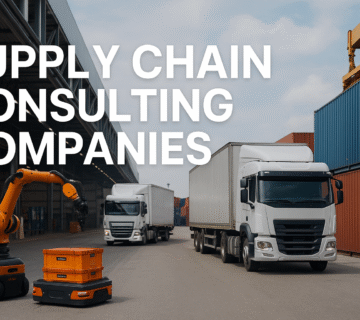Introduction
Table of Contents
ToggleIn today’s globalized economy, businesses are no longer isolated entities. They are part of vast networks of suppliers, manufacturers, distributors, and retailers — all working together to deliver products and services to consumers. This complex web is known as the supply chain, and managing it efficiently is crucial for success. This is where Supply Chain Management (SCM) comes in.
SCM is more than logistics. It’s a strategic approach to planning, executing, and optimizing the flow of goods, information, and finances across the entire supply chain — from raw materials to final delivery.
1. Understanding Supply Chain Management
Definition
Supply Chain Management is the coordination and management of all activities involved in sourcing, procurement, production, and logistics. It ensures that the right product reaches the right place at the right time — at the lowest possible cost and with maximum customer satisfaction.
Key Components of SCM
- Planning – Forecasting demand and aligning supply chain activities.
- Sourcing – Selecting suppliers and managing procurement.
- Manufacturing – Production scheduling, quality control, and efficiency.
- Delivery & Logistics – Warehousing, transportation, and distribution.
- Returns – Handling defective or excess products (reverse logistics).
2. The Importance of SCM in Business
Efficiency and Cost Reduction
SCM helps businesses reduce waste, avoid delays, and minimize costs by streamlining operations and improving coordination.
Customer Satisfaction
A well-managed supply chain ensures timely delivery, product availability, and quality — all of which enhance customer experience.
Risk Management
SCM identifies potential risks (e.g., supplier failure, geopolitical issues) and builds resilience through contingency planning and diversification.
Competitive Advantage
Companies with agile and responsive supply chains can adapt faster to market changes, giving them an edge over competitors.
3. Types of Supply Chains
1. Make-to-Stock (MTS)
Products are manufactured based on demand forecasts and stored until sold.
2. Make-to-Order (MTO)
Production begins only after a customer places an order — common in customized goods.
3. Engineer-to-Order (ETO)
Highly customized products designed and built from scratch for each customer.
4. Just-in-Time (JIT)
Inventory is minimized by receiving goods only when needed — reducing storage costs.
4. Technologies Transforming SCM
1. Artificial Intelligence (AI)
AI enables predictive analytics, demand forecasting, and intelligent automation. It helps businesses make data-driven decisions and respond to disruptions quickly.
2. Internet of Things (IoT)
IoT devices track shipments, monitor warehouse conditions, and provide real-time visibility across the supply chain.
3. Blockchain
Blockchain ensures transparency and traceability, especially in industries like food, pharmaceuticals, and luxury goods.
4. Robotics and Automation
Automated warehouses and robotic process automation (RPA) improve speed and accuracy in logistics and inventory management.
5. Cloud Computing
Cloud-based SCM platforms enable real-time collaboration between global partners and provide scalable infrastructure.

5. Meta AI and the Future of Supply Chain Management
What Is Meta AI?
Meta AI is the artificial intelligence research and development arm of Meta (formerly Facebook). It focuses on cutting-edge technologies like machine learning, natural language processing, and computer vision.
Meta AI’s Role in SCM
Meta AI is contributing to SCM in several transformative ways:
- Demand Forecasting: Using deep learning models to predict consumer behavior and market trends.
- Optimization Algorithms: Enhancing route planning, inventory control, and resource allocation.
- AI-Powered Chatbots: Improving customer service and supplier communication.
- Computer Vision: Automating quality control and warehouse management through image recognition.
- Sustainability Modeling: Helping companies reduce carbon footprints by optimizing energy use and transportation.
Meta’s AI research is also being integrated into platforms that support e-commerce, retail, and logistics, making supply chains smarter and more adaptive.
6. Challenges in Supply Chain Management
1. Global Disruptions
Events like pandemics, wars, and natural disasters can halt supply chains. SCM must be resilient and flexible.
2. Cybersecurity
Digital supply chains are vulnerable to data breaches and cyberattacks.
3. Sustainability
Consumers and regulators demand eco-friendly practices, pushing companies to rethink sourcing and logistics.
4. Talent Shortage
SCM requires skilled professionals in logistics, analytics, and technology — a growing challenge for many firms.
Fact 6: Your Data is Your Most Valuable (and Underused) Asset
1. Global Disruptions
Events like pandemics, wars, and natural disasters can halt supply chains. SCM must be resilient and flexible.
2. Cybersecurity
Digital supply chains are vulnerable to data breaches and cyberattacks.
3. Sustainability
Consumers and regulators demand eco-friendly practices, pushing companies to rethink sourcing and logistics.
4. Talent Shortage
SCM requires skilled professionals in logistics, analytics, and technology — a growing challenge for many firms.
7. Best Practices in SCM
- Invest in Technology: Use AI, IoT, and cloud platforms to enhance visibility and control.
- Build Strong Relationships: Collaborate closely with suppliers and partners.
- Diversify Suppliers: Avoid dependency on a single source.
- Monitor KPIs: Track performance metrics like delivery time, inventory turnover, and order accuracy.
- Focus on Sustainability: Adopt green logistics and ethical sourcing.
Conclusion
Supply Chain Management is no longer just a back-office function — it’s a strategic driver of business success. With the rise of AI, IoT, and platforms like Meta AI, SCM is becoming smarter, faster, and more customer-centric. Whether you’re a global enterprise or a growing startup, mastering SCM is essential to thrive in today’s interconnected world.
F.A.Qs
Frequently asked questions
Logistics is a subset of SCM focused on transportation and warehousing. SCM covers the entire process from sourcing to delivery.
AI predicts demand, automates tasks, and optimizes routes — reducing costs and improving responsiveness.
Retail, manufacturing, healthcare, food & beverage, and e-commerce are heavily reliant on SCM.
Reverse logistics handles returns, recycling, and disposal of products — crucial for sustainability and customer satisfaction.
Yes. Cloud-based SCM platforms and AI tools are increasingly accessible to SMEs, helping them compete with larger firms.
Resilience refers to a supply chain’s ability to recover from disruptions and continue operations with minimal impact.
By leveraging your agility and focus. You can't outspend them, so you must outmaneuver them.
Niche Down: Serve a specific customer segment better than anyone else.
Personalize: Offer unparalleled personal service and build stronger customer relationships.
Be Faster: Make decisions and launch new initiatives quickly, while large competitors are slowed by layers of management.
Specialize: Become the absolute best at one thing, rather than being average at many.
Other Questions
General questions
Trax Group moves beyond generic advice to provide integrated, actionable strategies. We don't just identify opportunities; we partner with you to implement solutions across Marketing, Technology, and Operations simultaneously. Our unique "3D" methodology—Discover, Develop, Deploy—ensures our strategies are deeply data-driven, creatively executed, and built for measurable, sustainable growth, not just short-term gains.
Absolutely. This is a core strength of our practice. For established businesses, we conduct a deep-dive Business Growth Audit to diagnose the specific barriers preventing scaling, whether they are in market positioning, operational inefficiencies, or technology limitations. We then develop a tailored Growth Acceleration Plan focused on unlocking new revenue streams, optimizing customer lifetime value, and breaking into new markets to reignite expansion.
Yes. Our integrated agency model is designed for this exact scenario. Our team of specialists works seamlessly under one roof, managing everything from brand strategy and digital marketing campaigns to CRM implementation and sales process optimization. This eliminates the friction of coordinating multiple vendors and ensures that every piece of your growth engine is aligned and working toward the same goal, providing you with a single point of accountability.







No comment